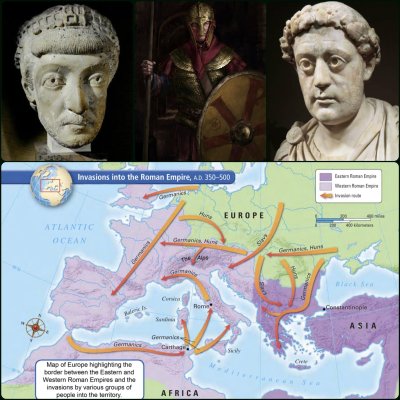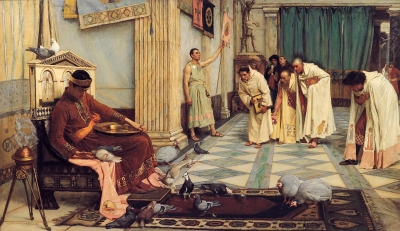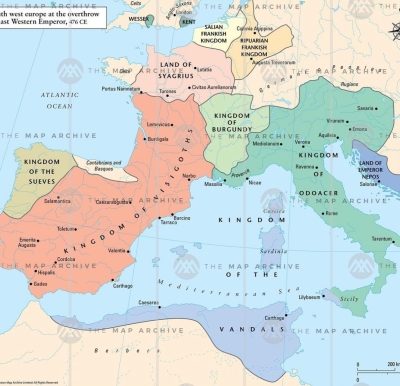
How did the Eastern Roman Empire “react to the collapse of its western counterpart? Did it remain indifferent?” No, “Eastern Roman emperors dispatched military expeditions of comparatively large size to the western Mediterranean at various times during the 5th century.” As the geopolitical situation in the Roman west declined it became clear that “it was only from the east that the hard-pressed western emperors might expect large-scale assistance…” The only hope the Western Romans had was if the East could somehow liberated North Africa from Vandal rule.
Firstly, “Theodosius II sent military assistance to his uncle, Honorius, against Alaric’s invasion of Italy (410). The historian Sozomen’s description of the circumstances surrounding the arrival in Italy of Byzantine relief forces indicates how close Honorius’ ties were with the eastern empire: ‘ships were ready, if necessary, to convey Honorius to his nephew when unexpectedly six arithmoi — about 4000 men — arrived at Ravenna during the night from the east.’” This may not sound like much to send 4,000 men, but the East had its own problems & transporting them by sea “involved a substantial sacrifice of eastern resources.” This aid may have saved Honorius, but Rome was still sacked by the barbarians, a huge blow to the city and to the image of the Roman Empire. Their enemies could see the Romans were so weak in the West they could not even protect Rome.

Another intervention was in 423 after the death of Honorius. The Eastern Empire helped Valentinian III & his mother Galla Placidia secure control of the West. The barbarian generals Ardaburius & Aspar were sent west with “a large eastern army” to help reclaim the throne from rivals. After the victory, the sources even say the people of Constantinople celebrated the victory in the West upon hearing the news – demonstrating “the deep interest of the leaders and ordinary people of the east in western affairs.”
Again Theodosius II dispatched aid in 431-434 to help defend Roman Africa from the Vandals, however, “the Vandal King Geiseric defeated the Byzantine expeditionary force and managed to capture the future Byzantine Emperor, Marcian (450-457).” Theodosius was paying the Huns for peace, thus he was able to send some troops west due to that.
Once more Theodosius II sent troops in 441 when he “dispatched by sea a large contingent of troops” to try to “destroy the Vandal kingdom. This force reached Sicily, but never saw action against the Vandals, for a devastating Hunnic invasion…compelled the eastern emperor to recall his troops.” This was a huge missed opportunity, “the expedition was very large, possibly compromising 1,100 ships.” Geiseric offered peace before the battle could even be fought, but when the fleet withdrew of course his stance shifted.
Attila took up the attention of the Eastern Romans in the 440’s, thus they did not have the spare armies or budgetary surplus required for the kind of help the West needed. When Marcian succeeded Theodosius II, his policy was more passive, and he had “pledged to avoid conflict of arms with the Vandals” after his earlier capture by Geiseric.
“Marcian’s successor, Leo I (457-474) immediately reversed his predecessor’s policy of nonintervention in the west.” In the midst of a Western succession crisis “Leo apparently first considered assuming the direct government of both east and west. He altered his decision, however, and allowed Majorian to become magister militum and Caesar in the west, but refused to recognize him as Augustus when Majorian assumed that title.” But Majorian was murdered in 461, and replaced by Libius Severus, chosen by Ricimer, a barbarian general.
Leo only wanted to help an emperor he approved of, and Ricimer accepted the appointment of Anthemius to replace the deceased Severus in 465. Thus, a huge push to destroy the Vandal Kingdom was hatched. Leo spent 130,000 pounds of gold on the expedition and was to send 1100 ships. However, the massive fleet sent in 468 “failed miserably; the fleet was destroyed.”

In 470, some attacks launched from Egypt were made against the Vandals, but they did not change the course of history. Leo had tried to “save Italy” by retaking Africa for the West. But he had failed. By 476, there was nothing left to save. The Eastern Romans were on their own now, but they weren’t going anywhere any time soon. Rome was gone but Constantinople would stand strong!

Source:
Byzantium and the Fall of Rome by Walter Kaegi

